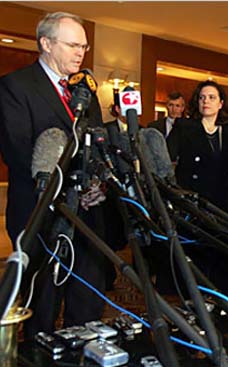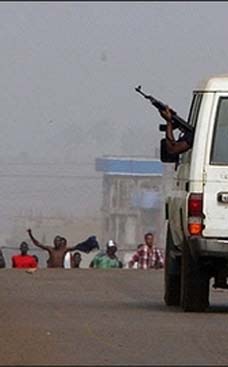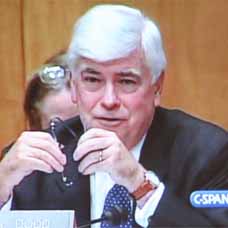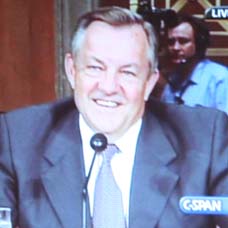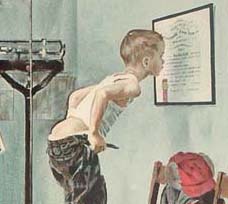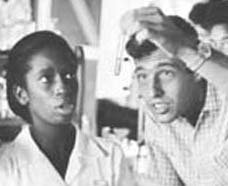
Kent is no stranger to working in Africa. A former Peace Corps volunteer, he speaks French and Arabic, and he has visited two- thirds of the continent's nations. He also is no stranger to its hardships. Twenty years ago, in the Peace Corps in Mauritania, he taught poor farmers how to grow rice. Electricity, running water and bathrooms didn't exist. Two children in his host family died within his first two months. At the Danforth Center, Kent says, he can work for bigger changes. He has traded the warmth of village experiences for the stiff handshakes of officialdom. Now, he wears suits. "The goats in the street, or the kids making cars out of cans of condensed milk, or donkeys on the highway, or matatus with 100 people hanging off of them - those things don't catch my attention anymore," he says.
Getting the genetically engineered cassava into the ground in Africa is the job of Mauritania RPCV Lawrence Kent, a Danforth Center nonscientist whose job depends on this science being put to use
A ST. LOUIS TEAM FIGHTS A CROP KILLER A VIRUS IS WIPING OUT MUCH OF AFRICAS MOST IMPORTANT FOOD. CAN SCIENTISTS OVERCOME THE OBSTACLES TO A BIOTECH CURE?
Dec 10, 2006
St. Louis Post-Dispatch
The sleepy main street of Nakitoma, with its pancake seller and bicycle repairman, is little different from that of other provincial towns - just a flash of weathered, empty storefronts on the pocked road.
Barefoot children chase cars, calling out, "Bye-bye, Museveni!" For if someone is driving a car around here, he must be someone important, such as Ugandan President Yoweri Museveni.
It is a forgettable place, except for one thing: It is the epicenter of a pandemic whose shock waves still are ravaging Africa.
Not AIDS. Not malaria. Not tuberculosis. But something just as destructive.
It was here, 18 years ago, that a virus swept into fields of cassava. Cassava is a food staple and a source of income for hundreds of millions of Africans. The potato-like plant sustains African farmers when their less hardy crops fail. The virus has spread into at least nine countries and has cut cassava yields in half.
Christopher Mukiibi's cassava patch is still sickly. Sitting outside in a yellow foam chair by a pile of rotting mangoes, Mukiibi, 75, eats a breakfast of corn porridge and boiled cassava. An oily smoke rises from the ruins of his crumbling kitchen hearth.
"It's the main crop that has sustained my family," he says through a translator. His palsied hands tremble. He asks for food and sugar. "I need assistance."
That assistance might come from the basement of the Donald Danforth Plant Science Center in Creve Coeur, where a little cassava plant grows in a puddle of hormones, its leaves pressed and straining against a plastic petri dish.
Scientists genetically engineered the plant in 1999 to resist the virus. Since then, they have been trying to give the technology away.
But African nations, caught between the United States and Europe in a smoldering fight over biotechnology, have yet to allow field tests on their soil.
The Danforth Center scientists acknowledge that a virus- resistant cassava won't solve African hunger on its own. Hunger is a complex issue, and poverty, war, substandard health care, poor roads and exploding populations all play roles.
But international aid workers are watching the Danforth Center as it attempts to bring the first nonprofit biotech product to Africa.
First and foremost, the cassava project is a scientific experiment. The Danforth Center is coaxing governments to accept a technology that is still a work in progress.
The project also will test the role biotechnology has to play in stemming hunger by boosting crop yields. Biotech has yet to make much of an impact on Africa's poorest, who, some agricultural scientists say, could benefit more from investment in roads and fertilizer.
Finally, the cassava project is an experiment in the viability of nonprofit biotechnology. The 5-year-old Danforth Center is one of just a few public-sector biotech centers that freely licenses technology for humanitarian purposes. The center tackles crops ignored by the private sector because they are grown in poor countries where there isn't a market for biotech.
Last year, the Bill and Melinda Gates Foundation selected four of these "orphaned" crops - rice, banana, sorghum and cassava - for grants that would support development of genetically engineered nutritional enhancements. Some of the money went to the Danforth Center.
Getting the genetically engineered cassava into the ground in Africa is the job of Lawrence Kent, a Danforth Center nonscientist whose job depends on this science being put to use. Bolstered by the new donor money, Kent went last summer to Uganda, Malawi and Kenya to make his pitch to officials.
"There hasn't been a public-sector success story for developing countries, and we'd all like to create one," he says. "There is pressure on us to succeed."
A pandemic emerges
The teenage boy in the Minnie Mouse T-shirt takes a chunk of cassava, skins it with his fingernail and bites into its raw, white flesh, a reward after a long day of hoeing. The woman who hired him also will pay him a little more than $1. She decided to uproot her tiny forest of cassava and pile the roots on a truck bound for Kampala, Uganda's capital. There, the 220-pound sacks of cassava will be sold fresh for just more than $20 - about $5 more than the woman could get in her local market.
Boiled like a potato, ground into a flour or eaten raw, cassava is a low-maintenance crop that can be found almost everywhere in Africa. It grows in poor soils and requires little water and little attention. Harvests are flexible: Roots can be left in the ground for two or three years and eaten in times of trouble. Pound for pound, cassava produces more starch per acre than any other staple food crop.
But the plant has a flaw: mosaic virus. First discovered in 1894, the virus produces a yellow mosaic pattern as it withers the leaves. Without that photosynthetic area, rootwads are puny. A plant that might ideally produce 10 big "potatoes" instead offers up just a few small ones or none at all.
Routinely, mosaic infections cause farmers to lose a fifth of their crops, says James Legg, an entomologist in Tanzania who has studied cassava mosaic disease for years.
But in Uganda in the late 1980s, the virus mutated into something harsher. The new mosaic virus reduced cassava to barren stalks with useless roots. Farmers abandoned entire fields.
The virus has raced across the countryside, spread by the bite of the tiny and ubiquitous whitefly. It also has spread when farmers sowed new cassava fields using the diseased stalks from infected plants.
Legg completed a survey this year that conservatively estimates a 47 percent overall loss to cassava farmers in the pandemic area, which includes at least nine nations, perhaps 11.
He worries about the pandemic, which like a storm front is moving 50 miles a year toward Nigeria, the biggest cassava producer in the world.
"This is huge," he says. "Farmers can't make any money from their crops. They have to eat everything they have."
Legg's loss estimate doesn't reflect the farmers who have given up on cassava and turned instead to crops such as corn, which is far more susceptible to drought.
While Legg documents the losses from cassava mosaic disease, Kent, the Danforth Center's director of international programs, fantasizes about what African farmers could gain with a resistant plant.
If losses are almost half, then a resistant plant could double production. All that extra cassava could be sold, Kent says, and pay for things such as milk, medicine, newspapers, school fees and batteries.
"For a poor family, that's a huge difference in the quality of life," he says.
Pursuing permission
Kent rises with the roosters on a cool, cloudy morning in Kampala. Outside the gated hotel walls, bicycles, scooters and matatus - minivans that serve as Africa's unregulated bus service - begin to honk and squeal as they compete for road space. Electricity returns to a country that suffers power cuts every night.
Kent's plane was delayed from Kenya. He didn't check into his hotel until after 1 a.m. The mosquito netting was torn, and the air conditioner didn't work. He slept poorly.
He takes a bath and shaves and pops an anti-malaria pill. He prepares his papers for his first meeting, an important one, with the director of Uganda's agricultural research organization. He looks weary on this, the eighth day of a whirlwind 10-day trip.
"Is it Monday?" he asks no one in particular.
Another day, another African city, another slew of official meetings. Kent wants to get the resistant cassava into the hands of farmers, but he first has to bend the ears of government officials who are debating whether to accept biotech.
Kent is no stranger to working in Africa. A former Peace Corps volunteer, he speaks French and Arabic, and he has visited two- thirds of the continent's nations.
He also is no stranger to its hardships. Twenty years ago, in the Peace Corps in Mauritania, he taught poor farmers how to grow rice. Electricity, running water and bathrooms didn't exist. Two children in his host family died within his first two months.
At the Danforth Center, Kent says, he can work for bigger changes. He has traded the warmth of village experiences for the stiff handshakes of officialdom. Now, he wears suits.
"The goats in the street, or the kids making cars out of cans of condensed milk, or donkeys on the highway, or matatus with 100 people hanging off of them - those things don't catch my attention anymore," he says.
A driver in a sport utility vehicle shows up at 7:30 a.m. to pick up Kent. He enters the madness of morning rush hour.
Kent has been making trips such as this since he joined the Danforth Center in 2002.
Nigeria was very interested in the biotech cassava at first. The Danforth Center flew Nigeria's national biosafety committee to St. Louis. But the committee postponed approval meetings.
In 2004, Malawi nearly approved a field trial, but it was held up indefinitely by one official.
Kenya is the furthest along. In 2004 it allowed a limited test in which resistant cassava plants were tested in a closed greenhouse. But in the two years since, the national biosafety committee, through postponement after postponement, has avoided approving a field test.
"We spend a lot of time ramming our heads into the same walls over and over again," Kent says.
Africa remains uncertain about the future of biotechnology. Only South Africa allows biotech crops to be grown and sold. And only a few nations - Algeria, Benin and Zambia - ban biotech. The rest seem on the fence, eager for the debate to play out before they commit.
Delays are common in Africa for many things, not just biotech. In a place where good roads and fixed bus schedules are practically nonexistent, waiting is just a part of everyday life.
Waiting also is a part of science. Back in 1986, Danforth Center President Roger Beachy, then at Washington University, invented the method that scientists are using to engineer the cassava. He found that inserting bits of viral DNA into a tobacco plant gives it resistance to that virus, almost like a vaccine.
A few years later, Claude Fauquet, a Danforth Center plant scientist who was also at Washington University at the time, read about the technique and began applying it to his specialty, cassava. So biotech cassava has been a work in progress for almost two decades - and Fauquet still is refining the technology.
Last spring, he discovered that offspring from the cassava developed in 1999 had suddenly lost their resistance to the mosaic virus. The current cassava was engineered more cleanly, Fauquet says, and should retain its resistance. He feels lucky to have caught the problem. If field tests had gone ahead with the old cassava, many would have declared the technology a failure.
Legg, the cassava expert, says that biotech cassava will be useful one day, but in the meantime, traditional breeders already have had some success creating a resistant cassava.
"There is the sense that the hype outweighs the potential value of (biotech cassava)," he says.
In Serere, Uganda, an agricultural researcher showed off fields of healthy cassava that had been crossbred with related species for resistance to the mosaic disease. Near the research station, farmers still grow the old, susceptible cassava.
Scientists at the Danforth Center say the new breeds aren't culturally acceptable, so farmers don't use them.
"It doesn't taste right. It doesn't cook right," Kent says. Some farmers complain about the consistency of the porridge made from this cassava; others complain about the taste. The Danforth Center plans to produce customized, resistant versions of the preferred cassava varieties, region by region.
"Neither of us has a quick solution," Kent says.
Beachy initially thought the virus resistance technique would have been used on crops within five years of its discovery.
"It takes longer than just delivering a pill or putting up a school or digging a well. Critics say, 'Why aren't you doing this faster?' " Beachy says.
Waiting ... and waiting
There are few nonprofit or public-sector precedents to guide the Danforth Center. No nonprofit biotech product has yet helped the developing world.
In 1992, Monsanto donated training and money to a Kenyan scientist to make a virus-resistant sweet potato. A decade later, after millions of dollars in funding, field tests showed the modified variety no less vulnerable to disease than conventional sweet potatoes.
Another public-sector example, a biotech papaya, was a success story - but only in the United States.
In 1992, the ringspot virus entered the main papaya-growing region of Hawaii. In six years, it had cut fruit production in half.
In that time, the U.S. Department of Agriculture genetically engineered a virus-resistant version, showed good field-test results, obtained intellectual-property licenses and gave seeds to farmers.
Now, more than half of the papaya grown in Hawaii is genetically engineered. USDA scientist Dennis Gonsalves says biotech saved the papaya industry.
The technology could be used in the developing world. Scientists have engineered resistant papayas for Jamaica, Venezuela, Brazil and Thailand. Field tests have been done. But none of the nations have allowed farmers to begin growing them.
"So you just wait," Gonsalves says.
Public-sector scientists say they also are hamstrung by meager funding. Monsanto says that it costs up to $100 million to bring a biotech product to market. Public-sector biotech centers don't have that much money; the Danforth Center's endowment isn't even that big.
But last year, the center was part of a consortium that won a $7.5 million grant from the Gates Foundation. The consortium not only is targeting the cassava virus resistance, but also is trying to add vitamins, minerals and proteins to the plant while subtracting compounds that make some varieties of cassava poisonous and that make it spoil.
This year, Monsanto gave the center $7.5 million more for cassava work. Fauquet counts more than $30 million now available for cassava research worldwide.
"We have never had this for cassava before," he says.
The money has allowed Fauquet to turn his laboratory into a halfway house - something between an academic institution and a business.
Before, he had two people working on the project. Now, he has 18. Before, he could evaluate 200 cassava plants at once. Now, 1,500. He needs twice as much greenhouse space, and, with cassava overflowing in the center, he is renting space in Earth City.
The research is slogging, unsexy work, but for Fauquet, there is urgency. As he waits for his little cassava plants to grow, African populations are exploding. There were 216 million hungry Africans in 2004, more than twice as many as in 1971.
"We cannot afford to neglect this crop," he says.
And the mosaic disease marches on, laying fields to waste.
---
NONPROFIT BIOTECH FOR AFRICA
The Donald Danforth Plant Science Center in Creve Coeur is one of just a few nonprofit biotech institutes competing for agricultural research money. Some food policy experts say improving agriculture is the most fundamental way to alleviate poverty and hunger in Africa. These four biotech projects were among 43 global health research projects funded by the Bill and Melinda Gates Foundation last year after thousands applied for grants.
Cassava $7.5 million to a consortium led by Ohio State University to fortify cassava with vitamins and remove cyanideproducing compounds. The Danforth Center gets $3.3 million.
Rice $11.3 million to German researchers for a vitamin Aenriched golden rice. Introduction has been delayed because of difficulties securing intellectual property rights from companies.
Sorghum $16.9 million to Kenyan researchers to add vitamins and improve digestibility for this widely grown African cereal.
Banana $1.1 million to Australian researchers to engineer a forti. ed banana for Uganda, the second largest producer of bananas in the world.






